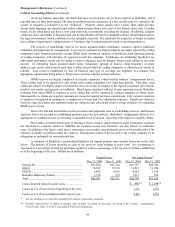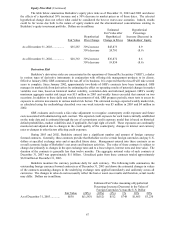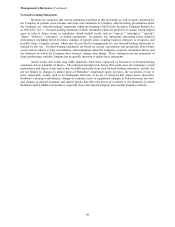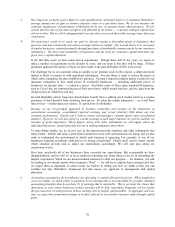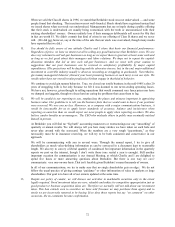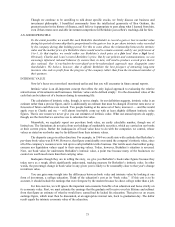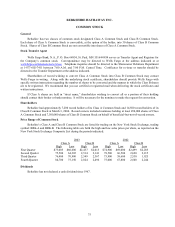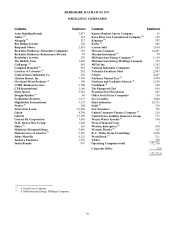Berkshire Hathaway 2003 Annual Report Download - page 74
Download and view the complete annual report
Please find page 74 of the 2003 Berkshire Hathaway annual report below. You can navigate through the pages in the report by either clicking on the pages listed below, or by using the keyword search tool below to find specific information within the annual report.73
Though we continue to be unwilling to talk about specific stocks, we freely discuss our business and
investment philosophy. I benefitted enormously from the intellectual generosity of Ben Graham, the
greatest teacher in the history of finance, and I believe it appropriate to pass along what I learned from him,
even if that creates new and able investment competitors for Berkshire just as Ben’ s teachings did for him.
AN ADDED PRINCIPLE
To the extent possible, we would like each Berkshire shareholder to record a gain or loss in market value
during his period of ownership that is proportional to the gain or loss in per-share intrinsic value recorded
by the company during that holding period. For this to come about, the relationship between the intrinsic
value and the market price of a Berkshire share would need to remain constant, and by our preferences at
1-to-1. As that implies, we would rather see Berkshire’s stock price at a fair level than a high level.
Obviously, Charlie and I can’t control Berkshire’s price. But by our policies and communications, we can
encourage informed, rational behavior by owners that, in turn, will tend to produce a stock price that is
also rational. Our it’s-as-bad-to-be-overvalued-as-to-be-undervalued approach may disappoint some
shareholders. We believe, however, that it affords Berkshire the best prospect of attracting long-term
investors who seek to profit from the progress of the company rather than from the investment mistakes of
their partners.
INTRINSIC VALUE
Now let’ s focus on a term that I mentioned earlier and that you will encounter in future annual reports.
Intrinsic value is an all-important concept that offers the only logical approach to evaluating the relative
attractiveness of investments and businesses. Intrinsic value can be defined simply: It is the discounted value of the
cash that can be taken out of a business during its remaining life.
The calculation of intrinsic value, though, is not so simple. As our definition suggests, intrinsic value is an
estimate rather than a precise figure, and it is additionally an estimate that must be changed if interest rates move or
forecasts of future cash flows are revised. Two people looking at the same set of facts, moreover — and this would
apply even to Charlie and me — will almost inevitably come up with at least slightly different intrinsic value
figures. That is one reason we never give you our estimates of intrinsic value. What our annual reports do supply,
though, are the facts that we ourselves use to calculate this value.
Meanwhile, we regularly report our per-share book value, an easily calculable number, though one of
limited use. The limitations do not arise from our holdings of marketable securities, which are carried on our books
at their current prices. Rather the inadequacies of book value have to do with the companies we control, whose
values as stated on our books may be far different from their intrinsic values.
The disparity can go in either direction. For example, in 1964 we could state with certitude that Berkshire’ s
per-share book value was $19.46. However, that figure considerably overstated the company’ s intrinsic value, since
all of the company’ s resources were tied up in a sub-profitable textile business. Our textile assets had neither going-
concern nor liquidation values equal to their carrying values. Today, however, Berkshire’ s situation is reversed:
Now, our book value far understates Berkshire’ s intrinsic value, a point true because many of the businesses we
control are worth much more than their carrying value.
Inadequate though they are in telling the story, we give you Berkshire’ s book-value figures because they
today serve as a rough, albeit significantly understated, tracking measure for Berkshire’ s intrinsic value. In other
words, the percentage change in book value in any given year is likely to be reasonably close to that year’ s change
in intrinsic value.
You can gain some insight into the differences between book value and intrinsic value by looking at one
form of investment, a college education. Think of the education’ s cost as its “book value.” If this cost is to be
accurate, it should include the earnings that were foregone by the student because he chose college rather than a job.
For this exercise, we will ignore the important non-economic benefits of an education and focus strictly on
its economic value. First, we must estimate the earnings that the graduate will receive over his lifetime and subtract
from that figure an estimate of what he would have earned had he lacked his education. That gives us an excess
earnings figure, which must then be discounted, at an appropriate interest rate, back to graduation day. The dollar
result equals the intrinsic economic value of the education.



